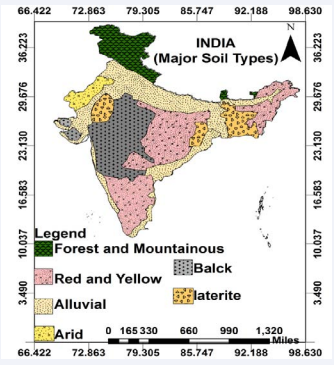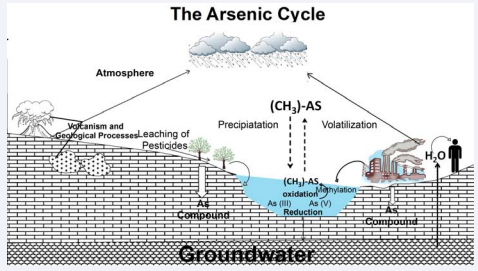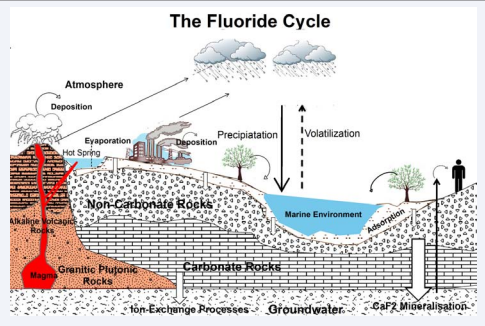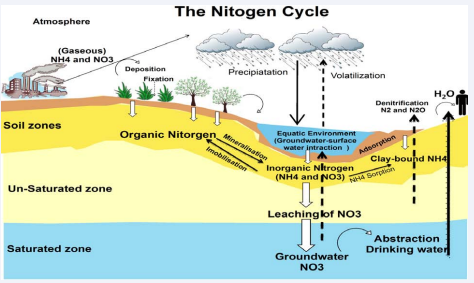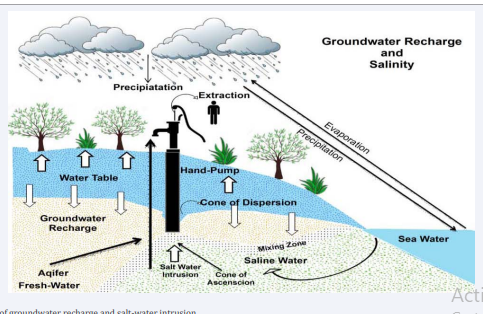Hydrogeological Influence on the Transport and Fate of Contaminants in the Groundwater, India
- 1. Visva-Bharati, Santiniketan, India
Abstract
High arsenic (As) fluoride (F- ) nitrate (NO3 - ) and salinity concentrations in groundwater are widespread problems in different part of Indian states. The various types of geological settings, hydro-chemical and diversified litho-logical characteristics as well as climatic condition are major responsible factors for enrichment of these contaminants in aquifer system. However, groundwater of Ganga–Meghna-Brahmaputra basin is in more vulnerable condition due to geogenic contamination. Furthermore, alluvial aquifers viz. Holocene alluvial and deltaic sediments are more contaminated due to the high concentration of arsenic, fluoride and nitrate. The mechanism of release of these contaminants in groundwater have been identified where numerous bio-geo-chemical process especially oxidation of sulphide mineralsis responsible for releasing of arsenic, weathering of granitic complex rocks are responsible for fluoride and leaching of agricultural waste is responsible for nitrate concentration in groundwater. In addition, evaporation, dissolution, precipitation, adsorption, co-precipitation, ion-exchange, oxidation-reduction and nature of aquifer have been identified as responsible factors for availability of these contaminants in the groundwater. Similarly, groundwater salinity problem has been detected in arid and semi arid as well as coastal region of India which is mainly due to over exploitation of groundwater. In this study, we have broadly discussed about the mechanism of release of these contaminants and their responsible factors with the help of different published research papers.
Keywords
Aquifers , Groundwater , Geogenic contaminants , Hydro-geo-chemistry
Citation
Kumar B, Singh UK, Mukherjee I (2017) Hydrogeological Influence on the Transport and Fate of Contaminants in the Groundwater, India. JSM Biol 2(1): 1009.
INTRODUCTION
Groundwater is considered as reliable source of fresh water which is easy to accessible for various purposes of human beings such as domestic, industrial, irrigation, propagation of fish etc [1]. Worldwide, approximately 1.5 billon peoples are directly or indirectly depend on the groundwater for their domestic and agricultural needs [2]. However, in last few years variety of geogenic contaminants in groundwater have been reported throughout globe [3-9]. Groundwater quality is generally controlled by geology, aquifer characteristics, climate, topography, sub-surface activities, and various geochemical processes [10-14]. The geochemical process like dissolution, hydrolysis, precipitation, adsorption and ion exchange, as well as oxidation-reduction and biochemical reaction are major controlling factors for the chemistry of groundwater [15]. It is quite interesting, about 80% rural and 50 % urban people of India directly depends on the groundwater whereas 56 % rural Indian access potable water from tube wells, 14% from open wells and 25% by supplied water system [16-17]. The groundwater contamination due to high concentration of fluoride (F- ), arsenic (As), nitrate (NO3 - ) and salinity has been immerged groundwater problem in India [18].
Arsenic groundwater contamination has got great attention in last few years because of carcinogenic nature and millions of persons residing in the arsenic prone zones throughout globe [19]. Geographically large areas of Indian states are affected by arsenic contamination [20]. Similarly, next important contamination is fluoride due to their toxicity, persistent capacity and accumulation in human bodies [21,22]. In last few decades, both contaminants present as major harmful contaminants in groundwater which affect millions of people in India [6]. Furthermore, nitrate is one of the most omnipresent chemical contaminant in many parts of world aquifers which especially arise from intensive agriculture, unsewered sanitation [23]. Salinity is not much harmful for human health as compare to other geogenic contaminants but it may be dangerous for ecosystem and soil productivity. Groundwater salinity is the widespread problem in India especially in western, northwestern and southern part of India [24]. These evidences clearly indicate that such contaminants directly or indirectly related to geogenic sources. Therefore, it is important to understand the hydro-geochemistry of the groundwater which may be helpful to evaluate the parent source of contaminants. In this study, we summarized some relevant works to indicate the geological relation with groundwater contaminants in context of Indian states.
Hydro-geological settings of aquifers
Figure 1 Hydro-geological settings of Indian states [25,26].
The groundwater characteristic in Indian states is very complicated due to numerous types of geological settings, diversified litho-logical characteristics, different climatic condition and various hydro-chemical conditions [25]. Figure (1) shows broad distribution of seven hydro-geological settings which describe groundwater topology of Indian states. The number of geological characteristic may also increased because many parts of Himalayan regions are still untouched with respect to geological classification [26]. However, India can be grouped under two broad hydrogeological units, namely porous and fissured formation based on the different hydraulic parameters. Further, porous formation has been classified into unconsolidated and semi consolidated formations which is covered by alluvial sediments of river basin and arrow valleys or structurally faulted basins. Similarly, fissured formation occupy almost two-third region of the country which form four groups such as igneous and metamorphic rocks, volcanic rocks, consolidated sedimentary rocks and carbonate rocks [27]. However, geological information of different part of Indian states is much diversified with different geological age and formations which control the hydrological condition of the particular areas (Table 1). Archaeans including Archaean Complex, Dharwars, Aravallis and associated gneisses and granite are geographically distributed over two third of peninsular India. It is one of the mineral rich areas of India which composed of coal, iron, copper, uranium and antimony. Furthermore, Cuddapahs, Vindhyans, Gondwanas, and Deccan traps are the second most geographically distributed in remaining peninsular areas [27]. Similarly, various types of lithological characteristics have found in India. There are six different types of soils found in India such as alluvial soils (occupied ~43% of the India), Black soils (occupied ~15% of the India), Red soils (occupied ~18.5% of the India), Laterite soil, Mountain soil and Arid soil (Figure 2) [28].
Figure 2 Distribution of major types of soil in India.
Nevertheless, groundwater contamination may result from various aquifer materials including presence of high concentration of contaminants in particular rock matrix [29]. Presently, Central Ground Water Board (CGWB) has adopted fourteen principal aquifer systems in India based on rock types, geology and terrains [27]. Thus, diversified hydro-geological settings of Indian states leads to complexity which is very difficult to evaluate and understand the exact source of contaminants in the groundwater [26]. In India, overexploitation of groundwater is greater than or closer to aquifer recharge rate [30]. Therefore, understanding of hydro-geochemistry is important for tracing the origin and pathways of groundwater chemical contaminants.
Groundwater geogenic contaminants
Arsenic (As): Groundwater As contamination has been get great attention in last few decades because of their carcinogenic nature and serious health concern. Furthermore, arsenic is recognized as one of the most serious inorganic contaminants of groundwater [31]. Approximately ten million people worldwide are residing in the risk zone of this metalloid [7,32]. Groundwater arsenic contamination is an emergent endemic contaminant in the various countries such as India, China, Mexico, Argentina, and Bangladesh [6]. There are various studies that investigated the
Table 1: Hydrogeological characteristics and rock compositions in Indian states [27].
| Geological Age/ Formations | Rock Formation/composition | Hydrological characteristics | Name of States |
|---|---|---|---|
| Jurassic (Rajmahal Traps and Deccan Traps) | Basalts, Dolerites, Diorites and Basaltic magma Quartzite | Unconfined shallow aquifers and leaky confined/confined deeper aquifers | West Bengal, Jharkhand, Gujarat, Maharashtra, Andhra Pradesh, Madhya Pradesh, Karnataka |
| Pre-Cambrian (Cuddapah, Vidhyans, Delhi, and Malani Volcanics) | Sandstones, Dolomites, Shales, Limestones, Marble, Conglomerates, IntrusiveGranites | Granites and granite gneisses are the most productive aquifers | Occur in all states |
| Archaean (Archaean Complex, Dharwars, Aravallis) | Granites, Quartzites, Gneiss, Schists, Hematite Charnokites, Phylites, Khondalites, Granulites | Granites and granite gneisses are the most productive aquifers | Occur in all states |
| Tertiary | Nummulitic shales, Limestones, Ferrugineous, Carbonaceous shales, Sandstones shales and Conglomerates | Lower Siwaliks (not potential aquifers) Upper Siwaliks (moderate potential aquifers) and Tertiary sandstones (moderate to good potentials) | Himachal Pradesh, Jammu & Kashmir, Assam, Punjab, Haryana, Uttar Pradesh, Sikkim, Kutch, Rajasthan, Gujarat, Orissa, Kerala, Tamil Nadu, Andhra Pradesh, West Bengal |
| Upper Carboniferous to Jurassic | Gondwanas Jurrasic of Kutch and Rajasthan, Bagh-beds and Lametas | Moderately to good potential aquifers | Maharashtra Andhra Pradesh, Rajasthan, Orissa, Madhya Pradesh, Chhattisgarh, Gujarat, Tamil Nadu |
| Pleistocene to Recent | Fluvio-Glacial deposits, GlacioLacustrine deposits | Significant hydrogeological potential | Interior Himalayas and Karewas (Kashmir Valley) |
| Piedmont and Himalayan Foot Hill deposits | Sand aquifers and deeper aquifer | Alluvial plains in south. Tarai belt is down slope continuation of Bhabhar | |
| Alluvial Plains (Older & Newer Alluvium) | Highly productive aquifers | Occur widespread in the Indo-GangaBrahmaputra alluvial plains peninsular rivers and major rivers on the eastern Gujarat |
groundwater arsenic problem in India [6,32-35]. The occurrence of high arsenic in groundwater has been reported in various states of India such as West Bengal, Bihar, Chhattisgarh, Uttar Pradesh and North Eastern States [36]. In the West Bengal, 79 blocks in 8 districts have high arsenic concentration in groundwater which is beyond the permissible limit of 0.05 mg/l. The eastern side of Bhagirathi River (Malda, Murshidabad, Nadia and North/South 24 Parganas) and western side (Howrah, Hugli and Bardhman) are the most affected areas of West Bengal [37]. The higher concentration of arsenic is also accounted in Ganges–Gaghra plain especially at Ballia district in eastern Uttar Pradesh and Bhojpur, Buxar and Shahebganj districts in Bihar [36,38]. Furthermore, elevated level of arsenic has been detected in twenty-four districts of Assam, three districts of Tripura, six districts of Arunachal Pradesh, two districts of Nagaland and one district of Manipur [36]. Therefore, arsenic contamination has been well established in the Ganga–Meghna-Brahmaputra delta basin because majority of the states lies within this delta which has high contamination of arsenic in groundwater which mainly due to various biogeochemical processes and deposition of sulphiderich sediments [39]. In view of Principal Aquifer Systems, alluvial aquifers (Holocene alluvial and deltaic sediments) are mainly affected by high concentration arsenic [40].
Figure 3 The arsenic cycle and its influence on the water resources.
In the groundwater, arsenic usually derives from sedimentary rocks, weathered volcanic rocks, geothermal areas and fossil fuels [41]. Arsenic is also present in more than 320 minerals and generally found in arsenopyrite, orpiment, realgar and pyrite solid solutions [42]. The list of major arsenic minerals which are occurring in the geological environment tabulated in (Table 2). Arsenic generally comes from the geogenic sources but release mechanism is not well understood [5,43]. However, mobilizations of arsenic in groundwater generally depend on variety of controlling factors (Figure 3) such as dissolution, precipitation, adsorption, co-precipitation, oxidation and reduction [5]. In general, reductive dissolution of Fe oxides in sedimentary.
Table 2: List of major arsenic minerals present in nature [47]
| List of As containing minerals | Composition | Occurrence | |
| Native arsenic | As | Hydrothermal veins | |
| Niccolite | NiAs | Vein deposits and norites | |
| Realgar | As2 S2 | Vein deposits associated with orpiment, clays and limestones | |
| Orpiment | As2 S2 | Hydrothermal veins, hot springs, volcanic sublimation product | |
| Cobaltite | CoAsS | high temperature deposits, metamorphic rocks | |
| Arsenopyrite | FeAsS | The most abundant As mineral | |
| Tennantite | (Cu,Fe)12As4 S13 | Hydrothermal vein | |
| Enargite | Cu3 AsS4 | Hydrothermal vein | |
| Arsenolite | As2 O3 | Secondary mineral formed by oxidation of arsenopyrite | |
| Clauderite | As2 O3 | Secondary mineral formed by oxidation of realgararsenopyrite | |
| Scorodite | FeAsO4 . 2H2 O | Secondary mineral | |
| Anabergite | (Ni,Co)3 (AsO4 )2 .8H2 O | Secondary mineral | |
| Hoernesite | Mg3 (AsO4 )2 .8H2 O | Secondary mineral, smelter wastes | |
| Haematolite | (Mn,Mg)4 Al(AsO4 )(OH)8 | Secondary mineral | |
| Conichalcite | CaCu(AsO4 )(OH) | Secondary mineral |
8FeOOH AS absorbed CH COOH 14H CO
8Fe AS Dissolved 16HCO 12H O
Further, desorption of Fe-oxyhydroxides for releasing As from Fe oxyhydroxides especially at pH greater than 8.5 has been reported as cause for the mobilization of As from Fe-oxides [50- 52]. The equation of desorption of FeOxydroxides for releasing as is given below;
FeOH As FeOAs H + + +
Fluoride (F): Undesirable concentration of fluoride in groundwater is one of the most natural groundwater quality problems in many parts of the world [53]. There are 200 million people of 25 nations residing in the risk zone of high fluoride concentrated groundwater [54]. A number of studies have been reported for groundwater fluoride problem in Indian states such as West Bengal [55,56], Andhra Pradesh [53,57], Rajasthan [58-60] and Tamil Nadu [29,61-62]. In the West Bengal, high concentration of fluoride (> 1.5 mg/L) is reported in some parts of the quaternary alluvial aquifers in Birbhum district due to presence of Granitic Complex and porphyrytic granitic gneiss rocks in Rajmahal volcanic trap along with favorable physico-chemical condition [55,56]. In Andhra Pradesh, various influencing factors have been detected for the occurrence of fluoride in the groundwater such as semiarid climates condition, evaporation, evapo-transpiration, precipitation of salts, rockwater interaction with the aquifer material and agricultural fertilizers [63,64]. Similarly, presence of alluvial plain, granite and gneisses rocks including topography of the Thoothukudi and Erode district as well as Amaravathi river basin, Tamil Nadu plays a major role in dissolution and leaching of fluoride into the groundwater [29,65]. Furthermore, presence of granitic or sandstone dominant aquifers in the Rajasthan is considered to be the main cause for fluoride in groundwater in this region [58,59].
Fluorite is colourful mineral commonly known by fluorspar which is naturally found with apatite ore. It is widely used in the aluminium production as an additive for electrolysis [66]. The mobilisation of fluoride in the groundwater depend on the numerous hydro-geochemical processes (Figure 4), such as rockwater interaction, infiltration of contaminated surface water from river, lake, streams, intrusion of seawater and geothermal fields [6]. However, dissolution, hydrolysis, precipitation, adsorption, ion-exchange, oxidation-reduction and biochemical reaction are important factors which influence the groundwater chemistry [15]. The major geogenic sources of fluoride are igneous and metamorphic rocks while, sedimentary formations also contribute least amount of fluoride in fluorine enriched clays and fluorapatite [67]. Furthermore, fluoride hosted rocks such as graniticsellaite, fluorite, cryolite, fluorapatite, apatite, topaz, fluormica, biotite, epidote, amphibole, pegmatite, mica, clays, villuanite, phosphoriteand sandstone are important geogenic sources of fluoride in the groundwater [68,69]. Nevertheless, the mechanism of fluoride dissolution process is still not wellunderstood [66]. Several researchers have described about the releasing mechanism of fluoride in the groundwater. Generally, high concentration of fluoride in groundwater detected in the high evaporation and low rainfall region from arid to semi arid part of the world [13]. Fluoride once deposited and released into the soil and leached into groundwater, may increase fluoride concentration, until fully saturated in the water [61].
Figure 4 The fluoride cycle and its influence on the water resources.
Ca 2F CaF
Some fluoride containing minerals like mica and amphiboles are well known for displacement of fluoride ion with OH- ion in the alkaline water [73,74]. The mechanism of the replacement of fluoride and OH- ion from the muscovite and biotite is given below;
Nitrate (NO3 - ): Nitrate naturally presents in moderate concentration in various environments and is the ubiquitous chemical contaminant in the world’s aquifers [75]. In the groundwater, the level of nitrate has been increased in last three decades [76] as a result of the intensive use of fertilizers, agricultural runoff, refuse dump and contamination with human or animal wastes [77]. Furthermore, some amount of nitrogenous compounds leaches into the groundwater through septic systems and leaking municipal sewers [78]. Nitrate groundwater contamination has become a serious problem in many parts of the Indian states. The elevated level of nitrate (> 45 mg/L) in groundwater has been reported in different parts of India [77,79-81]. Large portion of the western Rajasthan viz. Bhilwara, Rajsamand, Udaipur and Dungarpur belt is highly affected by nitrate contamination (40 to1000 mg/L) of groundwater [82]. Small pockets of high nitrate containing ground waters are found in Jhalawar, Bundi, and Baran belt of eastern Rajasthan [83]. However, the enrichment of NO3 - in groundwater also has been reported in agriculturally intensive areas in West Bengal [80], Uttar-Pradesh [77,84], Punjab [85], Haryana [86] and Andhra Pradesh [87]. They concluded that the elevated concentrations of nitrate in groundwater along these regions are mainly due to extensive application of nitrogenous fertilizer.
Nitrate is most ubiquitous form of nitrogen that is highly mobile in water [88]. However, the distribution of NO3 - in groundwater is controlled by a number of factors (Figure 5) such as hydro-geological setting, thickness and composition of the vadose zone, precipitation, irrigation, groundwater flow, land-use pressure, soil type, aquifer heterogeneity, dissolved oxygen concentrations and redox potential conditions [75]. High concentration of nitrate in groundwater is generally found in unconsolidated aquifers due to their unconfined nature and shorter travel time than bedrock aquifers [89]. Some studies revealed that the unconsolidated aquifers have greater affinity for NO3 - because of leaching of NO3 - through the coarse grained deposits [90]. Furthermore, the higher permeable aquifers are more prone to NO3 - contamination as compared to the lower permeable aquifers [91]. However, in the nitrification process NH4 + is converted into NO2 - and consequently NO3 - during microbial oxidation process [78].
Furthermore, NO3 - can be derived from NH4 + especially when the concentration of NH4 + higher than 0.15 mg/L in groundwater and commonly referred to as nitrification [92]. Some NH4 + may be lost due to assimilation into bacteria and sorption to clay minerals as wells as loss through volatilization.
Figure 5 The nitrogen cycle and its influence on the water resources.
Salinity: Salinity is another important groundwater contaminant but it does not cause serious health effects as compared to other geogenic contaminants. However, arid and semiarid zones are largely affected by salinization especially coastal aquifers [93]. Salinity problem has been detected in western, north-western and southern part of India where almost all major aquifer system (Alluvium, Granite, Schist, Shale and also in Deccan Traps and Limestone) is affected by salinization [94]. Groundwater salinization is very complex process, which is directly or indirectly related with regional geological characteristics and climatic conditions (Figure 6). Approximately 1.90 lakh km2 areas of India states like Haryana, Delhi, Uttar Pradesh, Karnataka, Punjab, Rajasthan, Gujarat and Tamil Nadu is affected by salinity [95]. Furthermore, saline-water intrusion in coastal areas has been reported in the states of Tamil Nadu, West Bengal, Orissa, Gujarat and Andhra Pradesh due to over-pumping of groundwater at large scales [94]. Several studies have identified a number of major responsible factors which has potential to enhance the salinity in groundwater such as vaporite dissolution, downward leakage from surficial saline water, improperly constructed wells deep brines or upward flow from deep saline water and fossil sea-water [96]. In coastal areas, the occurrence of sea water intrusion and sea spray enhances salinity in groundwater [97]. However, coastal areas, which are more prone to groundwater salinization by seawater intrusion due to over exploitation of groundwater and may cause deterioration of, water quality for future exploitation [98]. Furthermore, when seawater imposes into the aquifer the subsequent reverse ionic exchange reactions occur [99]. ( ) ( ) 2 2Na K Ca 2Na K Ca + + + + + = + ( ) ( ) 2 2Na K Mg 2Na K Mg + + + + + = + Further, salinization by groundwater seepage has been a major water quality problem for a long time [100]. Upward leakage from a deeper confined aquifer into a shallow aquifer water-bearing horizon may also result of high salinity ingroundwater [101]. The groundwater salinity is also affected by climatic condition such as evaporation of surface water from shallow basins of arid and semiarid zones may concentrate salt content in the groundwater [102].
Figure 6 Mechanism of groundwater recharge and salt-water intrusion
CONCLUSION
Keeping in view, the rapid expansion of geogenic contaminants viz. arsenic, fluoride, nitrate and salinity in groundwater in different parts of Indian states may result into serious health hazards to the large population in that area. The present study reveals that agriculture-derived nitrate pollution has dynamically changed the groundwater chemistry due to leaching of NO3 - from this nonpoint source pollution. Further, arsenic and fluoride contamination in a vast area of the Ganges and Brahmaputra basin probably derived from geogenic origins. In addition, large portion of alluvial plain are highly contaminated with theses contaminants which can cause detrimental condition of aquifers that will be hazardous for population in future. Similarly, increasing trend of salinity in Indian aquifers needs some immediate remedial measurements for proper management of water. The integrated research should be applied to understand the sources, release mechanisms, and mobilization of these contaminants in the aquifers. However, this study will be helpful to understand the geogenic contaminants and their mechanism of availability in Indian aquifers to a great extent
ACKNOWLEDGMENTS
Authors would like to thank University Grants Commission (UGC), Government of India (F. No. 42- 437/2013 (SR)), for financial grant through major research project. We wish to thank editor and the anonymous reviewers for their suggestions and critical comments
REFERENCES
15.Mathess G. The properties of groundwater. Wiley, New York. 1982.
24.Lorenzen G, Sprenger C, Baudron P, Gupta D, Pekdeger A. Origin and dynamics of groundwater salinity in the alluvial plains of western Delhi and adjacent territories of Haryana State, India. Hydrol Process. 2011; 2267-2274.
25.Shankar PSV, Kulkarni H, Krishnan S. India’s Groundwater Challenge and the Way Forward. Econ Polit Wkly. 2011; xlvi: 37-45.
30.Central Ground Water Board (CGWB) State Report, Hydrogeology of Chhattisgarh. NCCR Raipur. 2006; 180.
35.Patel KS, Sahu BL, Dahariya NS, Bhatia A, Patel RK, Matini L, et al. Groundwater arsenic and fluoride in Rajnandgaon District, Chhattisgarh, northeastern India. Appl Water Sci. Springer Berlin Heidelberg. 2015; 1-10.
45.Das D, Chatterjee A, Samanta G, Mondal B, Roy Chowdhury T. Arsenic contamination in groundwater in six districts of West Bengal. Analyst. 1994; 119: 168-170.
62.Kamla M, Sankar K. Flourine contamination in groundwater of amaravathi river basin, tamilnadu, india. Int J Recent Sci Res. 2012; 6: 6304-6310.
67.Ozsvath DL. Fluoride and environmental health: A review. Rev Environ Sci Biotechnol. 2009; 8: 59-79.
75.Spalding RF, Exner ME. Occurrence of Nitrate in Groundwater—A Review. J Environ Qual. 1993; 22: 392.
78.Fetter CW. Contaminant Hydrogeology. Englewood Cliffs. NJ: PrenticeHall. 1999.
89.Burkart MR, Kolpin DW. Hydrologic and land use factors associated with herbicides and nitrates in near surface aquifers. J Environ Qual. 1993; 22: 646-656.
94.Central Ground Water Board (CGWB). Concept Note on geogenic contamination of ground water in India. 2014; 1-99.
99.Appelo CAJ, Postma D. Geochemistry, groundwater and Pollution. Balkema. Rotterdam. 1994.
101. Araguas LJ. Identification of the mechanisms and origin of salinization of groundwater in coastal aquifers by isotope techniques. In: IGME (Ed.), Tecnologia de la intrusion de agua de mar en acuiferos costeros: paisesmediterraneos. Alicante, Spain. 2003; 365-371.
![Figure 1 Hydro-geological settings of Indian states [25,26].](https://www.jscimedcentral.com/public/assets/images/uploads/image-1672318142-1.png)
